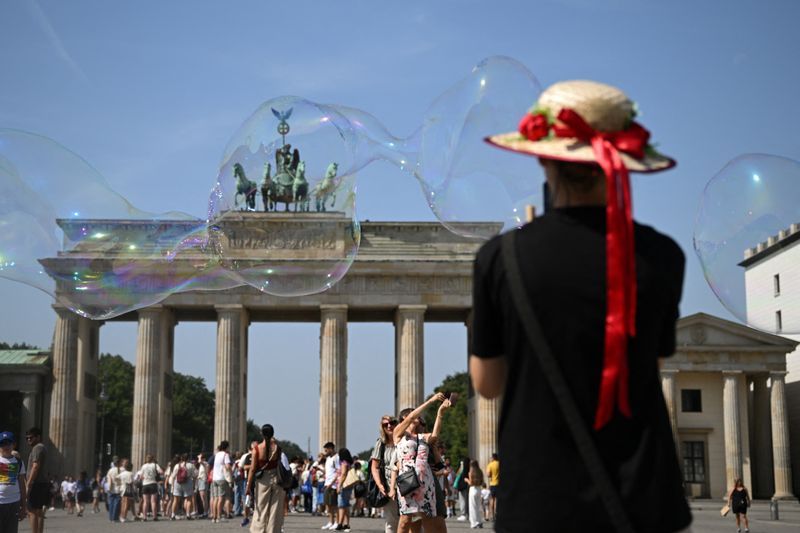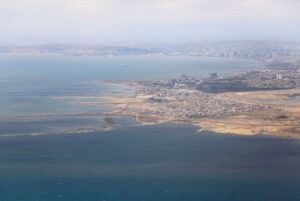
BERLIN (Reuters) -As many southern European cities grow tired of tourists, Berlin is pitching itself as an antidote to the crowds, blistering heatwaves and anti-tourism protests causing problems elsewhere.
The German capital is promoting its cutting-edge art scene, Prussian palaces and famed techno clubs to boost a tourism sector that has lagged behind the post-pandemic boom seen in other parts of Europe.
“We really don’t have a problem with overtourism,” said Christian Taenzler, spokesperson for the VisitBerlin tourism board. “The city is large and people spread out. Especially in summer, when Berliners are away, there’s quite a lot of space.”
Berlin – home to about 4 million people – drew 5.9 million visitors in the first half of the year, accounting for 13.9 million overnight stays, according to the Berlin-Brandenburg statistics office. That marks a fall of 1.8% and 2.9% respectively from a year earlier.
Hotel occupancy averaged 52.8% during the same period, lagging Madrid’s 65% and 79% in Paris, cities where tourism has rebounded more quickly since the COVID-19 pandemic.
In 2019, before the pandemic, Berlin drew nearly 14 million tourists, with 34 million overnight stays.
Tourism generated 4.6% of Berlin’s output in 2023, including indirect effects, according to the estimates of a DIW Econ study.
In comparison, tourism accounts for roughly 14% of the local economy in Paris and Rome, and 8% in Madrid, and Berlin is more reliant on cost-conscious German travellers.
Meanwhile, international arrivals fell by 4.7% in the first half.
CLIMATE TRENDS
Some tourist boards hope climate trends will shift demand north in the years to come. A European Commission Joint Research Centre study found heatwaves are making southern destinations less attractive in peak summer.
“While this theme may well emerge over the coming years, there is little evidence of it so far,” said Adrian Prettejohn, Europe economist at Capital Economics, noting that so far there has been only a shift to the off-peak season.
Taenzler said Berlin – where maximum summer temperatures are normally about 25 degrees Celsius (77 degrees Fahrenheit) – should appeal to tourists seeking cooler climes.
“We are a very green city, with a lot of water and swimming options, and a lot of shade … I think that will gain in importance in the future,” Taenzler said.
Industry figures blame weaker international visitor growth partly on Berlin’s new airport, BER, which opened in 2020.
In 2024, BER passenger numbers rose 10.4% to 25.5 million, well below the 35.7 million handled by the former Tegel and Schoenefeld airports combined in 2019.
“Recovery in passenger volumes is just under 85% for Germany,” said Ralph Beisel, head of the ADV airports association.
Low-cost carrier Ryanair said in August last year it would cut flights at BER by 20%. Ryanair’s DAC CEO Eddie Wilson has repeatedly complained about taxes, noting that Berlin’s airport has capacity for 50 million passengers.
Despite higher airfares, Berlin’s restaurants, hotels and attractions remain relatively affordable.
“Prices in Berlin are absolutely moderate,” said Jan Philipp Bubinger, managing partner of the Staendige Vertretung restaurant.
Some people blame Berlin’s disappointing tourist numbers on months of negative headlines about cutbacks in the cultural sector, traditionally one of its biggest draws.
Berlin’s government wants to cut about 130 million euros from the 2025 culture budget.
“What’s being done here is catastrophic budgeting,” Greens lawmaker Julian Schwarze said. “If the impression arises that culture is being lost, then I’ll save myself the trip to Berlin.”
(Reporting by Maria Martinez and Rene Wagner;Additional reporting by Ulrike Heil and Lena Toepler;Editing by Helen Popper)






